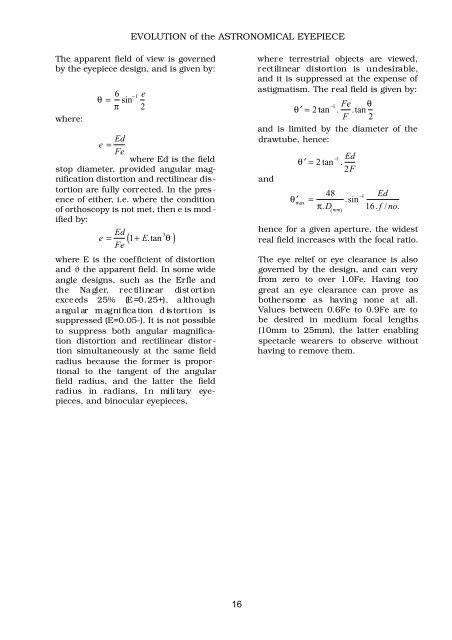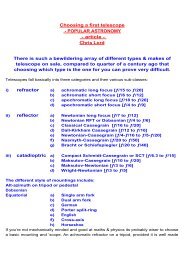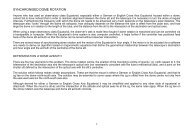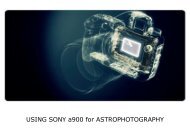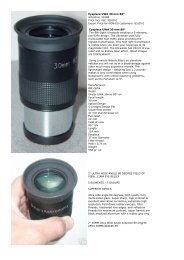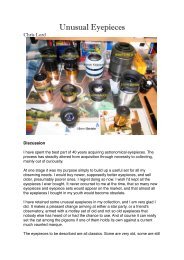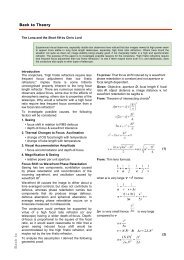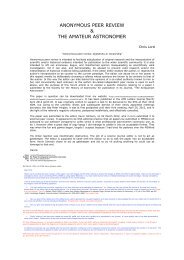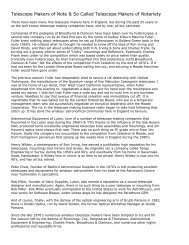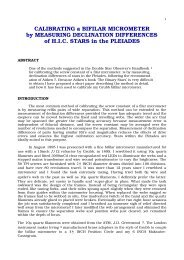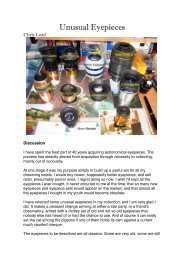Evolution of the Astronomical Eyepiece - Brayebrook Observatory
Evolution of the Astronomical Eyepiece - Brayebrook Observatory
Evolution of the Astronomical Eyepiece - Brayebrook Observatory
You also want an ePaper? Increase the reach of your titles
YUMPU automatically turns print PDFs into web optimized ePapers that Google loves.
EVOLUTION <strong>of</strong> <strong>the</strong> ASTRONOMICAL EYEPIECE<br />
The apparent field <strong>of</strong> view is governed<br />
by <strong>the</strong> eyepiece design, and is given by:<br />
where:<br />
θ = 6 π sin−1 e<br />
2<br />
e = Ed<br />
Fe<br />
where Ed is <strong>the</strong> field<br />
stop diameter, provided angular magnification<br />
distortion and rectilinear distortion<br />
are fully corrected. In <strong>the</strong> pres -<br />
ence <strong>of</strong> ei<strong>the</strong>r, i.e. where <strong>the</strong> condition<br />
<strong>of</strong> orthoscopy is not met, <strong>the</strong>n e is mod -<br />
ified by:<br />
e = Ed (<br />
Fe 1+ E.tan 3 θ )<br />
where E is <strong>the</strong> coefficient <strong>of</strong> distortion<br />
and ϑ <strong>the</strong> apparent field. In some wide<br />
angle designs, such as <strong>the</strong> Erfle and<br />
<strong>the</strong> Na gler, rectilinear dist ortion<br />
exceeds 25% (E=0.25+), a lthough<br />
a ngul ar m agni fica tion d istortion is<br />
suppressed (E=0.05-). It is not possible<br />
to suppress both angular magnification<br />
distortion and rectilinear distor -<br />
tion simultaneously at <strong>the</strong> same field<br />
radius because <strong>the</strong> former is proportional<br />
to <strong>the</strong> tangent <strong>of</strong> <strong>the</strong> angular<br />
field radius, and <strong>the</strong> latter <strong>the</strong> field<br />
radius in radians. In mili tary eyepieces,<br />
and binocular eyepieces,<br />
wher e terrestrial objects are viewed,<br />
rectilinear distortion is undesirable,<br />
and it is suppressed at <strong>the</strong> expense <strong>of</strong><br />
astigmatism. The real field is given by:<br />
θ ′ = 2 tan −1 . Fe<br />
F .tanθ 2<br />
and is limited by <strong>the</strong> diameter <strong>of</strong> <strong>the</strong><br />
drawtube, hence:<br />
and<br />
θ ′ = 2 tan −1 . Ed<br />
2F<br />
θ max<br />
′ =<br />
48<br />
π.D mm ( )<br />
.sin −1 Ed<br />
16. f / no.<br />
hence for a given aperture, <strong>the</strong> widest<br />
real field increases with <strong>the</strong> focal ratio.<br />
The eye relief or eye clearance is also<br />
governed by <strong>the</strong> design, and can very<br />
from zero to over 1.0Fe. Having too<br />
great an eye clearance can prove as<br />
bo<strong>the</strong>rsome as having none at all.<br />
Values between 0.6Fe to 0.9Fe are to<br />
be desired in medium focal lengths<br />
(10mm to 25mm), <strong>the</strong> latter enabling<br />
spectacle wearers to observe without<br />
having to remove <strong>the</strong>m.<br />
16


